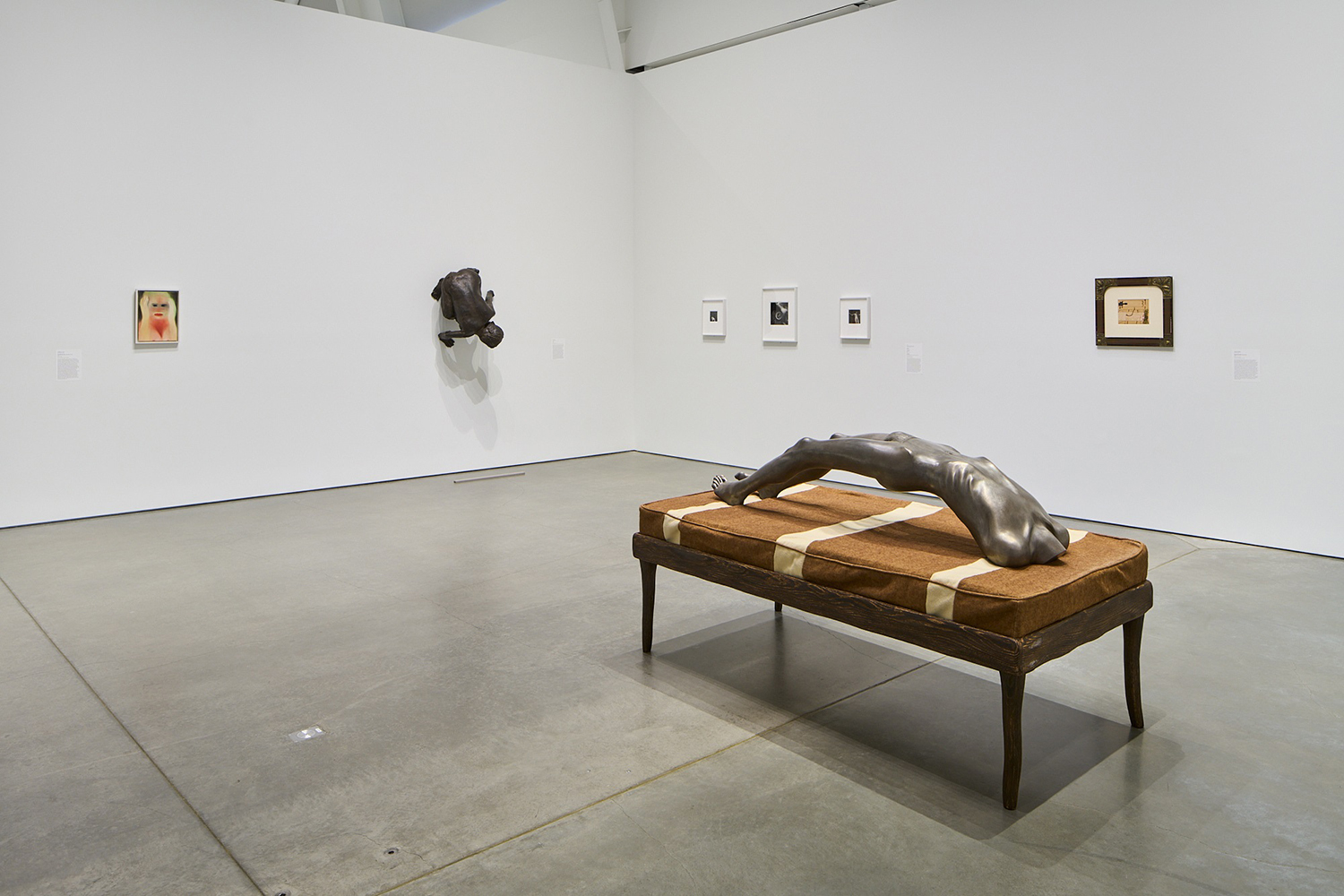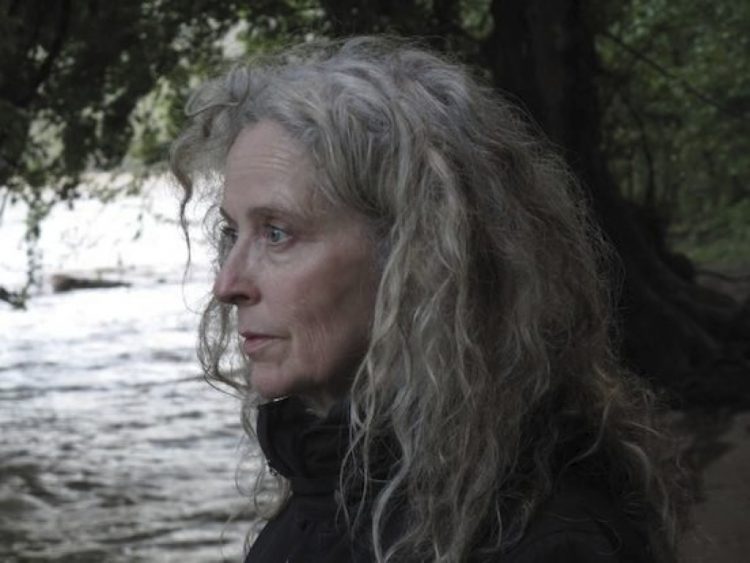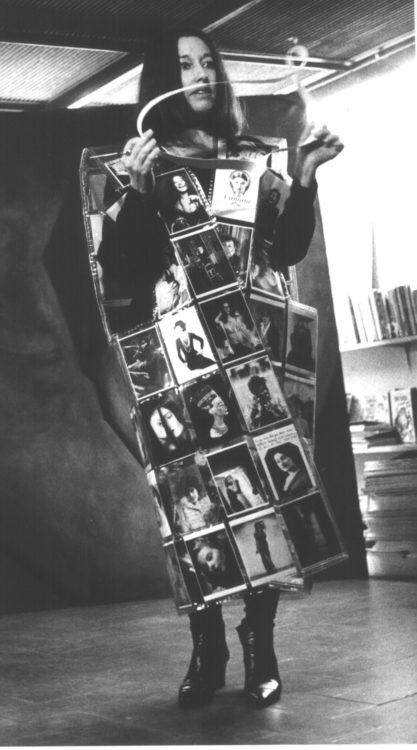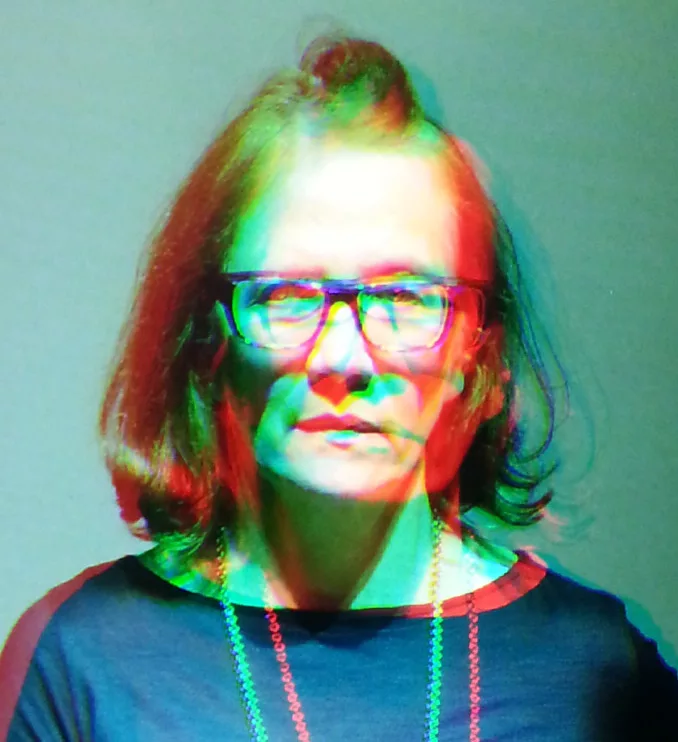Review
Exhibition view New Time: Art and Feminisms in the 21st Century, Berkeley Art Museum and Pacific Film Archive (BAMPFA), August 28, 2021–January 30, 2022
The exhibition New Time: Art and Feminisms in the 21st Century, curated by Apsara DiQuinzio and Phyllis C. Wattis, derives its name from a collection of poems by Leslie Scalapino.1 Bringing together works by seventy-seven artists and artists’ collectives, it is divided into eight sections and stands as a testimony to the diversity of values, strategies and lifestyles that have underpinned international feminist creation over the last twenty years. Each exhibition space opens on to another, thereby interweaving the gamut of issues at stake: “Prelude: Arch of Hysteria”, “Returning of the Gaze”, “Time as Fabric”, “The Body in Pieces”, “Gender Alchemy”, “Womxn Workers of the World Unite!”, “Too Nice for Too Long” and ‘The Future is Feminist”. From the outset, the museum’s inclusive agenda is illustrated by its use of the term womxn to embrace cisgender women as well as transgender and non-binary identities.

Exhibition view New Time: Art and Feminisms in the 21st Century, Berkeley Art Museum and Pacific Film Archive (BAMPFA), August 28, 2021–January 30, 2022
In the hallway of the Berkeley Art Museum and Pacific Film Archive (BAMPFA), a range of posters produced by the Guerrilla Girls collective, from its inception in 1985 through to 2018, challenge the protagonists of the art world and condemn its underlying inequalities. As its centrepiece, the first section highlights Arched Figure (1993) by Louise Bourgeois (1911-2010). The work features alongside Paul Richer’s corpus and the drawings of Jean-Martin Charcot2, charting the stereotypical behaviour of so-called “mad” women committed to asylums. The mysterious, powerful works of Inka Essenhigh (born 1969), Kiki Smith (born 1954) and Anne Walsh (born 1962) redirect and usurp this vision.
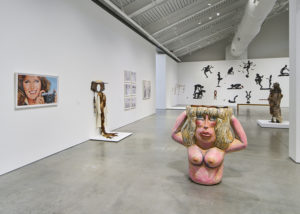
Exhibition view New Time: Art and Feminisms in the 21st Century, Berkeley Art Museum and Pacific Film Archive (BAMPFA), August 28, 2021–January 30, 2022
The bodies, active objects in their own right, bring the viewers face to face with themselves. The representation of non-normative naked bodies and the symbolism of absence segue into the inherent racial, lesbian and gender-related issues running through the history of art. The exhibition is an invitation to reflect on the deconstruction of the male gaze, which encumbers both the languid woman and the figure of the muse. The artists also address the way womxn have been objectified and excluded from the artistic discourse. The “Time as Fabric” section, by delving into myth and history, triggers a restorative new slant in which the process of weaving reaches beyond the actual technique to forge a whole network of womxn or “intralocutors”3 and transgress traditional effigies.
In the private sphere, relationships of domination are given form through corporeal fragments, inspired by the writings of Linda Nochlin.4 Visitors peruse fragments of revamped Afro wigs, underwear, vaginas and pregnant women, all disembodied from their individual whole. Self-representation is also illustrated by the proclamation of non-binary, gender-fluid and transgender identities. A queer section is devoted to those artists whose research revolves around the exploration of alternative realities. Zanele Muholi (born 1972) has collated these in a photographic series titled Brave Beauties(2014), which harks back to the Black is Beautiful movement launched in the 1960s.
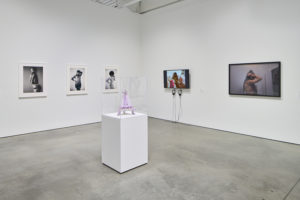
Exhibition view New Time: Art and Feminisms in the 21st Century, Berkeley Art Museum and Pacific Film Archive (BAMPFA), August 28, 2021–January 30, 2022
The markers of the feminist struggle against essentialism emerge in an iconographic portrayal of activism and the revolt against women’s labour and domestic violence. The TransLatina Coalition placards brandished in the drawings of Andrea Bowers (born 1965) and the video My Cuntry,’Tis of Thee (2018) by Marilyn Minter (born 1948), which in substituting the word “cunt” – often used as an insult – for the terms and slogans, are acts of protest in themselves. In the future, however, how can anger and utopia also be applied to this activism? Based on the founding work of feminist collectives in the 1970s, younger generation of womxn artists combine their strengths by sharing their concerns and their visions. Anohni (born 1971), Johanna Constantine, Kembra Pfahler (born 1961), Bianca Casady (born 1982) and Sierra Casady (born 1980) engraved The 13 Tenets of Future Feminism (2013) against male violence and domination on pink quartz circles. To round off the exhibition, Les Guérillères (2016) by Mai-Thu Perret (born 1976), depicting an army of womxn ready for combat, seem to be setting the feminist revolution in motion.
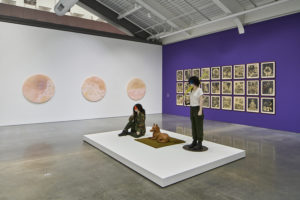
Exhibition view New Time: Art and Feminisms in the 21st Century, Berkeley Art Museum and Pacific Film Archive (BAMPFA), August 28, 2021–January 30, 2022
This exhibition is the logical continuation, in a way, of its ground-breaking predecessor WACK! Art and the Feminist Revolution, held at the Los Angeles Museum of Contemporary Art in 2017, which focused on the period 1965-1980. The years 2021-2022 have seen Californian museums clearly opting for an intersectional policy in their choice of programmes. BAMPFA’s focus on complex and multifarious approaches – intergenerational, gender-fluid, queer, racial and class-based – has kindled fresh and galvanising research through the lens of feminisms thanks to their enlightened portrayal of contemporary struggles.
Scalapino, Leslie, New Time, Middletown, CT: Wesleyan University Press, 1999.
2
Richer, Paul, Études cliniques sur la grande hystérie ou hystéro-épilepsie, Paris : A. Delahaye & E. Lecrosnier, 1885.
3
This notion was used by Rochelle Goldberg (born 1984) as the title of her hybrid sculpture Intralocutor, “Does the ground support you?” (2017).
4
Nochlin, Linda, The Body in Pieces: The Fragment as a Metaphor of Modernity , New York:, Thames and Hudson, 1994.
New Time: Art and Feminism in the 21st Century, 28 August 2021-30 January 2022, at the Berkeley Art Museum and Pacific Film Archive, Oakland, California, United States.
Laura Aguilar, Anohni, Kembra Pfahler, Johanna Constantine, Bianca Casady, Sierra Casady, Janine Antoni, Alisa Baremboym, Valérie Blass, Louise Bourgeois, Andrea Bowers, Sarah Cahill, Miriam Cahn, Sophie Calle, Jordan Casteel, Elaine Cameron-Weir, Tammy Rae Carland, Jean-Martin Charcot, Paul Regnard, Paul Richer, Judy Chicago, Anne Collier, Amy Cutler, Moyra Davey, Nicole Eisenman, Inka Essenhigh, Ellen Gallagher, Chitra Ganesh, Andrea Geyer, Rochelle Goldberg, Nicki Green, Guerrilla Girls, Lynn Hershman Leeson, Kenyatta A.C. Hinkle, Jenny Holzer, Luchita Hurtado, Hayv Kahraman, Caitlin Keogh, Koak, Ella Kruglyanskaya, Liz Larner, Simone Leigh, Candice Lin, Kalup Linzy, Sarah Lucas, Goshka Macuga, Ad Minoliti, Marilyn Minter, Zanele Muholi, Ruby Neri, Catherine Opie, Mai-Thu Perret, Michele Pred, Farah Al Qasimi, Pussy Riot, Christina Quarles, R.H. Quaytman, Carol Rama, Favianna Rodriguez, Leslie Scalapino, Lara Schnitger, Davina Semo, Amy Sillman, Laurie Simmons, Lorna Simpson, Rose B. Simpson, Kiki Smith, Linda Stark, Sturtevant, Lava Thomas, Mickalene Thomas, Wu Tsang, Sara VanDerBeek, Catherine Wagner, Kara Walker, Ann Walsh, Francesca Woodman.
Adélie Leguen, "New Time: Art and Feminisms in the 21st Century." In , . URL : https://awarewomenartists.com/en/magazine/new-time-art-and-feminisms-in-the-21st-century/. Accessed 3 July 2025
